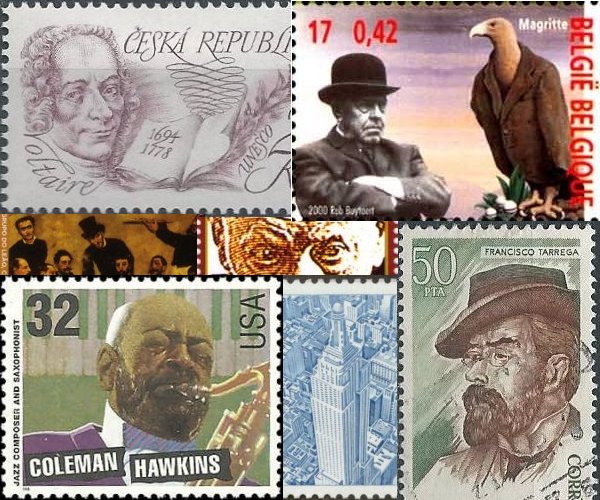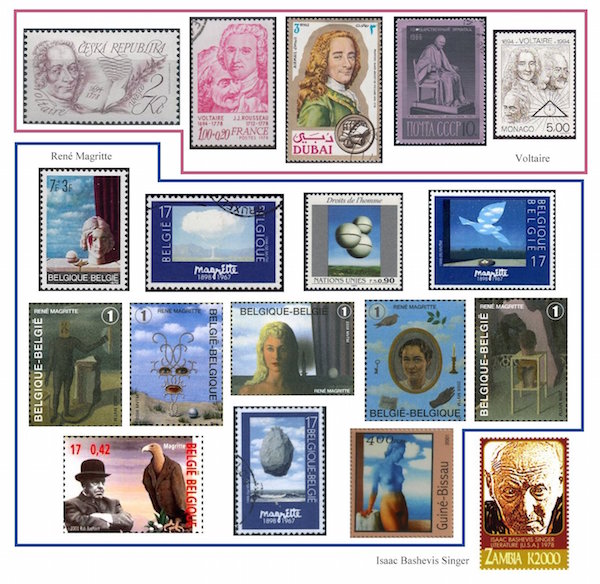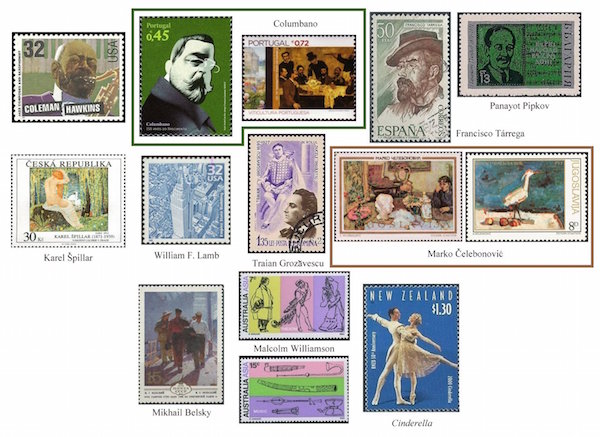The Arts on Stamps of the World — November 21
An Arts Fuse regular feature: the arts on stamps of the world.

By Doug Briscoe
November 21 brings us Voltaire, René Magritte, Isaac Bashevis Singer, and Coleman Hawkins, among others, including one of the principal designers of the Empire State Building.
It has always troubled me that my beloved Mozart celebrated the death of the “ungodly arch-villain” Voltaire, gratified that the French philosopher “died miserably like a dog.” I’m not sure whether “like a dog” means outside the comforts of Holy Mother Church or in great physical suffering, but in fact we don’t know whether either is true. Some say Voltaire accepted the Last Rites, some say he stuck by his atheist guns to the end. And I rather suspect the ones who claimed he died in torment were mostly just indulging their own “Christian” gloating. Well, Mozart may have been the greater genius, but he was certainly not the greater thinker. And Voltaire partisans can, I suppose, take the kind of vindictive glee that Mozart did on considering that the French writer lived to be 83, while the Austrian composer didn’t make it to 36. All of which, of course, goes to prove absolutely nothing theology-wise. But speaking of Voltaire and music, I’ll merely add that François-Marie Arouet (as he was born, 1694 – 30 May 1778) collaborated with Jean-Philippe Rameau on three stage works: Samson (now lost), La princesse de Navarre (revised as Les fêtes de Ramire), and Le temple de la gloire. Leonard Bernstein famously made an operetta of Candide in 1956. Voltaire’s verses were also set by Germaine Tailleferre (“Souvent un air de vérité“) and, in a Pushkin translation, by Rimsky-Korsakov, Glazunov, Arensky, and Cui.

Another decidedly irreverent Gallic creator was the Belgian surrealist René Magritte (November 1898 – 15 August 1967). Part of his world view may very well have been formed when his mother, who had repeatedly attempted suicide, finally succeeded by drowning herself when René was thirteen. It has further been suggested that when she was found, her soaking dress was over her face and that this image resurfaced in the painting Les Amants (The Lovers) of 1927-28. Magritte dallied with Impressionism, Futurism, and Cubism before arriving at his most recognizable style of Surrealism. His first exhibition in Brussels met with abuse and, depressed, Magritte went to Paris, where he made friends with André Breton and remained for three years, not greatly improving his standing. Back in Brussels in 1930 he resumed working in advertising and posters as he had done some years earlier. He had a show in New York in 1936. Magritte remained in Belgium during the occupation, and after the war he, along with several other Belgian artists, turned to a more optimistic expression of his art, called Surrealism in Full Sunlight. He also painted in a Fauvist style for a couple of years. At the same time, Magritte and his brother Paul turned to crime, not only producing forgeries of famous artists, but even counterfeiting banknotes. I guess they never did hard time in the slammer, though. As for art inspiring art (other than through outright forgery), Tom Stoppard wrote a surrealist play called After Magritte in 1970. And the actress Ellen Burstyn has said that the poster shot for The Exorcist (1973) was inspired by Magritte’s L’Empire des Lumières (The Empire of Light, c1950-54, now at MOMA). It sure looks like it, albeit without Magritte’s incongruous bright blue sky. A Magritte Museum has existed in Brussels since May 2009. Now, about the stamps. All but two are from Belgium. The first one shows Memory (1948). Next comes La corde sensible (1960). Then, on a stamp from the Geneva office of the UN, Voice of Space (1928), and, last on this row, The Return (1940). The middle row is given over to a full set of five Belgian stamps dated 2008: The Man from the Sea, Scheherazade, The Ignorant Fairy, Georgette, and The Midnight Marriage. In the bottom row, a stamp showing Magritte himself puts him with his work The Present (1939)—notice the recurrence of the three globes from Voice of Space. In the center is the iconic The Castle in the Pyrenees (1959), and finally, we have Black Magic (Magie Noire, 1979). That put me in mind of Le Viol (1934), which anticipates by decades an SNL episode from October 1991. Magritte’s image also appeared on a Belgian 500 franc banknote of 2009.
After all that, Isaac Bashevis Singer (November 21, 1902 – July 24, 1991) gets but a single stamp. (I’m rather surprised there isn’t yet one from Israel.) He was born Icek Hersz Zynger near Warsaw to a Hasidic rabbi. His mother’s name, Bathsheba, he later adopted as “Bashevis” in his pen name. The precise date of Singer’s birth is not entirely certain. He knew Russian well enough to read Crime and Punishment when he was fourteen. As a young man he worked with his brother as a proofreader for the Yiddish weekly Literarische Bleter. He came to the United States in 1935 and founded a literary magazine, Globus, with his friend, the Yiddish poet Aaron Zeitlin. This magazine serialized Singer’s first novel, Satan in Goray, but at the same time he was working as a columnist for The Jewish Daily Forward, another Yiddish-language newspaper. Indeed, Singer always wrote in Yiddish, and he also translated other’s works into the language, an example being The Magic Mountain by Thomas Mann, whose style of writing, oddly enough, Singer regarded as foreign to his own literary precepts. He was more in tune—even more oddly, perhaps—with the work of Knut Hamsun, whose body of work, much of which Singer also translated, was a strong influence. Isaac Bashevis Singer was awarded the Nobel Prize in Literature in 1978.
Jazz saxophonist Coleman Hawkins (November 21, 1904 – May 19, 1969) came from Saint Joseph, Missouri and played piano and cello and picked up the sax when he was nine. By the time he was fourteen, he was playing professionally, and at sixteen joined Mamie Smith’s Jazz Hounds. Hawkins settled in New York City in 1923 and played with Fletcher Henderson’s Orchestra until 1934, at which point he toured Europe for five years, performing alongside Django Reinhardt and others. Later musical partners back in the States would include Thelonious Monk and Miles Davis. Hawkins, known as “Hawk” or “Bean”, was among the earliest tenor saxophonists and is credited by some with having made the first bebop recordings with Dizzy Gillespie, bassist Oscar Pettiford, and drummer Max Roach.
There are those who regard Columbano Bordalo Pinheiro (Lisbon, 21 November 1857 – Lisbon, 6 November 1929) as the greatest of 19th-century Portuguese painters Columbano, who is usually referred to by that name alone, was the son and brother of artists, the father a painter, the brother a great caricaturist. A member of the artistic and intellectual Grupo do Leão (The Lion’s Group), he made a group portrait of them in 1885. This work is partly reproduced on one of the stamps, the other showing a caricature of the artist. (I assume this is not based on a work by Columbano’s caricaturist brother Rafael Bordalo Pinheiro.) In 1910 Columbano designed the national flag for the new Republican regime, still the flag of Portugal to this day. Columbano also served as director of Lisbon’s National Museum of Contemporary Art (now the Chiado Museum) from 1914 to 1927.
As a small child, Francisco Tárrega (21 November 1852 – 15 December 1909) injured his eyes when he fell into a ditch, and his father arranged for music lessons, reasoning that even if Francisco became completely blind (he didn’t), he could earn his living as a musician. When Francisco’s teacher Julián Arcas went on tour, Francisco, aged ten, ran away from home and tried to establish a career for himself by playing in the coffee houses of Barcelona. He must have been a very independent-minded youngster, for he ran away twice more before entering the Madrid conservatory in 1874. He himself was the teacher of Emilio Pujol and Miguel Llobet. In 1885, he returned with his wife to Barcelona, where he became friendly with Albéniz, Granados, Turina, and Pablo Casals. (Both of the latter two have birthdays next month.) Tárrega wrote 78 guitar pieces and 120 transcriptions, many of which were based on piano works of Beethoven, Chopin, et al.
Panayot Pipkov (21 November 1871 – 25 August 1942) was a Bulgarian composer and the father of composer Lyubomir Pipkov. He studied music at the Milan Conservatory from 1892 and held a number of directorial positions in his homeland. He wrote one opera and two children’s operettas, works for wind band, piano and violin pieces, choral songs, etc.
Czech painter and graphic artist Karel Špillar (November 21, 1871 – April 7, 1939) had two brothers who were also painters. As a young fellow he shared a studio and collaborated with Jan Preisler on a couple of significant projects, the Pavilion of the Prague Chamber of Commerce for the 1899 World Exhibition in Paris and the decoration of the Central Hotel in Prague. Špillar also worked with his brother Jaroslav on a series of large paintings for the meeting hall in the city of Kutná Hora in 1901. From 1902 to 1908 Špillar was in Paris and Normandy, where he co-founded a colony for Czech artists. He returned to Prague on the death of his father and the mental collapse of Jaroslav. The painting we see on the 2010 stamp is of Spring (Jaro, 1912). He became a professor at the Prague School of Applied Arts and executed various works in the Jugendstil, posters, illustrations, and murals. Among these is the mosaic he created above the entrance of the Municipal House, which contains Smetana Hall.

American architect William F. Lamb (November 21, 1893 – September 8, 1952) studied at Williams College, Columbia University, and the École des Beaux-Arts in Paris and went to work with a New York firm upon his return to the US in 1911. Nine years later he became a partner, and four years after that the firm became known as Shreve & Lamb (later, after 1929, Shreve, Lamb and Harmon). We have a stamp showing his most famous work, the Empire State Building. Other projects included the New York buildings for Standard Oil, Forbes Magazine, and General Motors and various academic buildings for the campuses of Williams College, Cornell, and Wesleyan.
Operatic tenor Traian Grozăvescu (1895 – 14 February 1927) was born to a Romanian father and a Serbian mother. After serving in the Austro-Hungarian Army in World War I he performed with the Cluj Opera, then, from 1922, at the Vienna State Opera, also achieving great successes in Budapest, Berlin, Prague, Salzburg, and Oslo. He was admired by Richard Strauss, Arturo Toscanini, and Pietro Mascagni. His wife Nelly fatally shot him with a revolver in a fit of jealousy, but she was found mentally incompetent and released.
Serbian painter Marko Čelebonović (21 November 1902 – 23 June 1986) was born in Belgrade and studied law and economics in England and in 1923 took up sculpture in the studio of Antoine Bourdelle in Paris. But he soon switched over to painting and gave his first exhibition in the Salon des Tuileries in 1925. The next month he relocated to Saint Tropez, where he resided for many years, joining the French Resistance during World War II. He did visit his homeland over the years, for example giving his first solo show in Belgrade in 1937. He returned to that city after the war and took up a post as a professor at the Academy of Fine Arts from 1948 to 1960. In these years he had many more shows in Zurich, Geneva, Sarajevo, and other cities besides Belgrade and Paris. Despite his long absence from his homeland he stated, “My life and work have been determined by my attitude towards Yugoslavia.” On the stamps from 1973 and 1981 we see Woman and Head and Bird on Blue Background.
We keep to 20th-century Slavic art for the Socialist Realist painter Mikhail Gabrilovich Belsky (1922 – 20 May 1994). He was a pupil at the Lugansk Art College and went to war while still in his teens, earning two decorations. The war over, he resumed his studies at the portrait studio of the Kiev Art Institute until 1951. He celebrated the noble proletariat in pieces such as the one on the stamp, Going to Work (or A Working Morning, 1960).
Australian composer Malcolm Williamson (21 November 1931 – 2 March 2003) was Master of the Queen’s Music from 1975 until his death, the first non-Briton to hold the post. He was born in Sydney and studied at the Conservatory there. One of his teachers was Eugene Goossens. In 1950 he relocated to London and, from 1953, studied with Elisabeth Lutyens. The topmost Australian stamp is one of set of three recognizing the links between Australia and Asia and, specifically, the 28th International Congress of Orientalists. Each stamp is a mini-triptych, this one depicting at left a Japanese No actor, at right a character from Chinese opera, and in the middle, I am informed, a dancer from Williamson’s 1964 ballet The Display. (The second stamp from the Australian set shows musical instruments: at top a Chinese pipe and trumpet, at center a didgeridoo, and at bottom a Thai fiddle, an Indian oboe, and Tibetan drums.)
Finally, the première of Prokofiev’s ballet Cinderella was given on November 21, 1945. The stamp is again one from a set, in this case one marking the 50th anniversary in 2003 of the Royal New Zealand Ballet.
A graduate of the University of Massachusetts with a B.A. in English, Doug Briscoe worked in Boston classical music radio, at WCRB, WGBH, and WBUR, for about 25 years, beginning in 1977. He has the curious distinction of having succeeded Robert J. Lurtsema twice, first as host of WGBH’s weekday morning classical music program in 1993, then as host of the weekend program when Robert J.’s health failed in 2000. Doug also wrote liner notes for several of the late Gunther Schuller’s GM Recordings releases as well as program notes for the Boston Classical Orchestra. For the past few years he’s been posting a Facebook “blog” of classical music on stamps of the world, which has now been expanded to encompass all the arts for The Arts Fuse.
